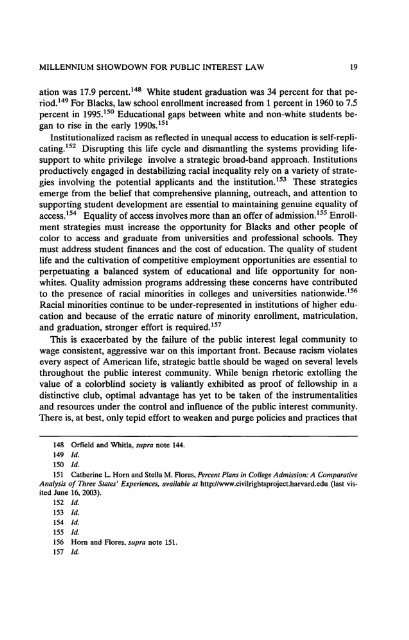Download Electronic Version - UDC Law Review
Download Electronic Version - UDC Law Review
Download Electronic Version - UDC Law Review
Create successful ePaper yourself
Turn your PDF publications into a flip-book with our unique Google optimized e-Paper software.
MILLENNIUM SHOWDOWN FOR PUBLIC INTEREST LAW 19<br />
ation was 17.9 percent. 148 White student graduation was 34 percent for that period.<br />
149 For Blacks, law school enrollment increased from 1 percent in 1960 to 7.5<br />
percent in 1995. 150 Educational gaps between white and non-white students began<br />
to rise in the early 1990s. 151<br />
Institutionalized racism as reflected in unequal access to education is self-replicating.<br />
152 Disrupting this life cycle and dismantling the systems providing lifesupport<br />
to white privilege involve a strategic broad-band approach. Institutions<br />
productively engaged in destabilizing racial inequality rely on a variety of strategies<br />
involving the potential applicants and the institution. 153 These strategies<br />
emerge from the belief that comprehensive planning, outreach, and attention to<br />
supporting student development are essential to maintaining genuine equality of<br />
access. 154 Equality of access involves more than an offer of admission. 155 Enrollment<br />
strategies must increase the opportunity for Blacks and other people of<br />
color to access and graduate from universities and professional schools. They<br />
must address student finances and the cost of education. The quality of student<br />
life and the cultivation of competitive employment opportunities are essential to<br />
perpetuating a balanced system of educational and life opportunity for nonwhites.<br />
Quality admission programs addressing these concerns have contributed<br />
to the presence of racial minorities in colleges and universities nationwide. 156<br />
Racial minorities continue to be under-represented in institutions of higher education<br />
and because of the erratic nature of minority enrollment, matriculation,<br />
and graduation, stronger effort is required. 157<br />
This is exacerbated by the failure of the public interest legal community to<br />
wage consistent, aggressive war on this important front. Because racism violates<br />
every aspect of American life, strategic battle should be waged on several levels<br />
throughout the public interest community. While benign rhetoric extolling the<br />
value of a colorblind society is valiantly exhibited as proof of fellowship in a<br />
distinctive club, optimal advantage has yet to be taken of the instrumentalities<br />
and resources under the control and influence of the public interest community.<br />
There is, at best, only tepid effort to weaken and purge policies and practices that<br />
148 Orfield and Whitla, supra note 144.<br />
149 [d.<br />
150 [d.<br />
151 Catherine L. Horn and Stella M. Flores, Percent Plans in College Admission: A Comparative<br />
Analysis of Three States' Experiences, available at http://www.civilrightsproject.harvard.edu (last visited<br />
June 16,2003).<br />
152 [d.<br />
153 [d.<br />
154 [d.<br />
155 [d.<br />
156 Horn and Flores, supra note 151.<br />
157 [d.














